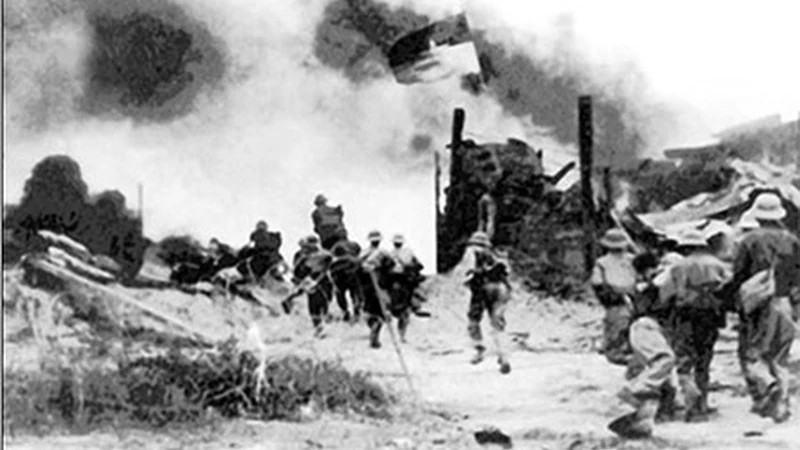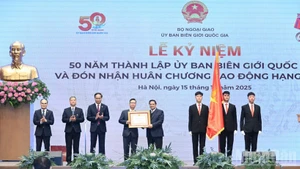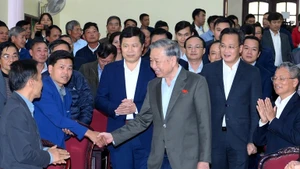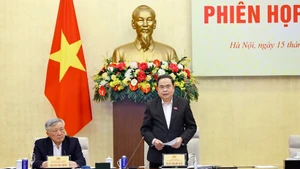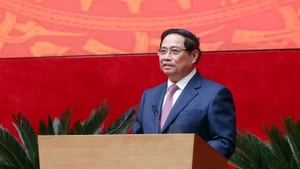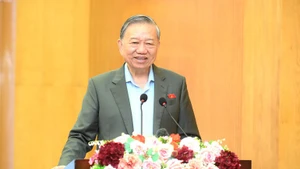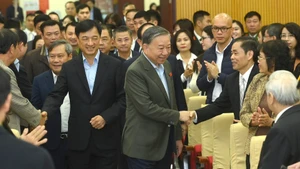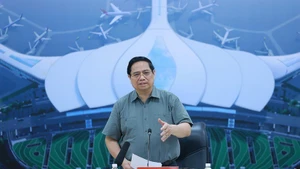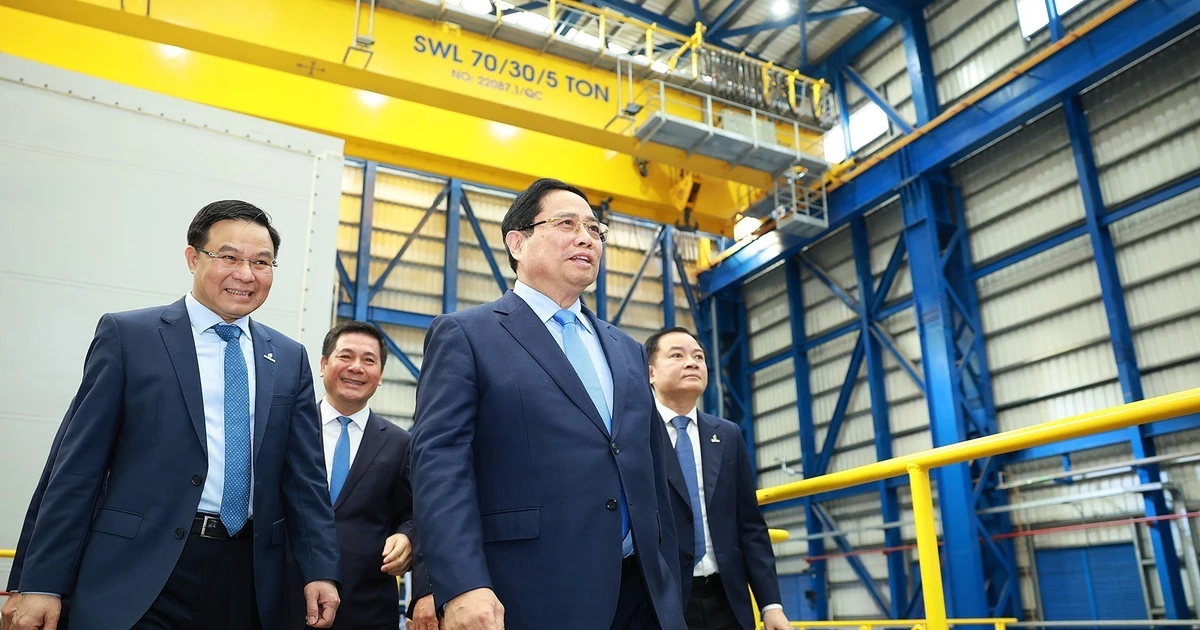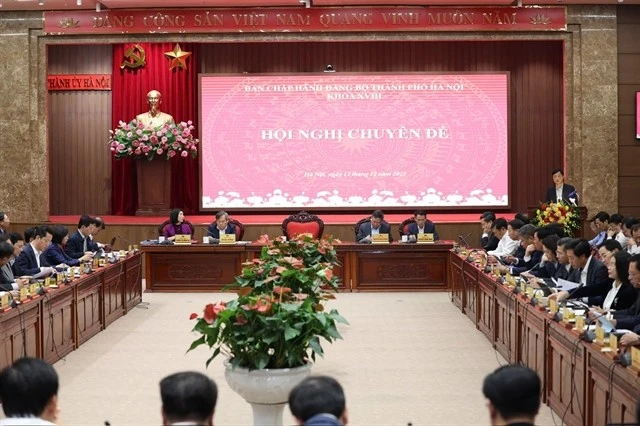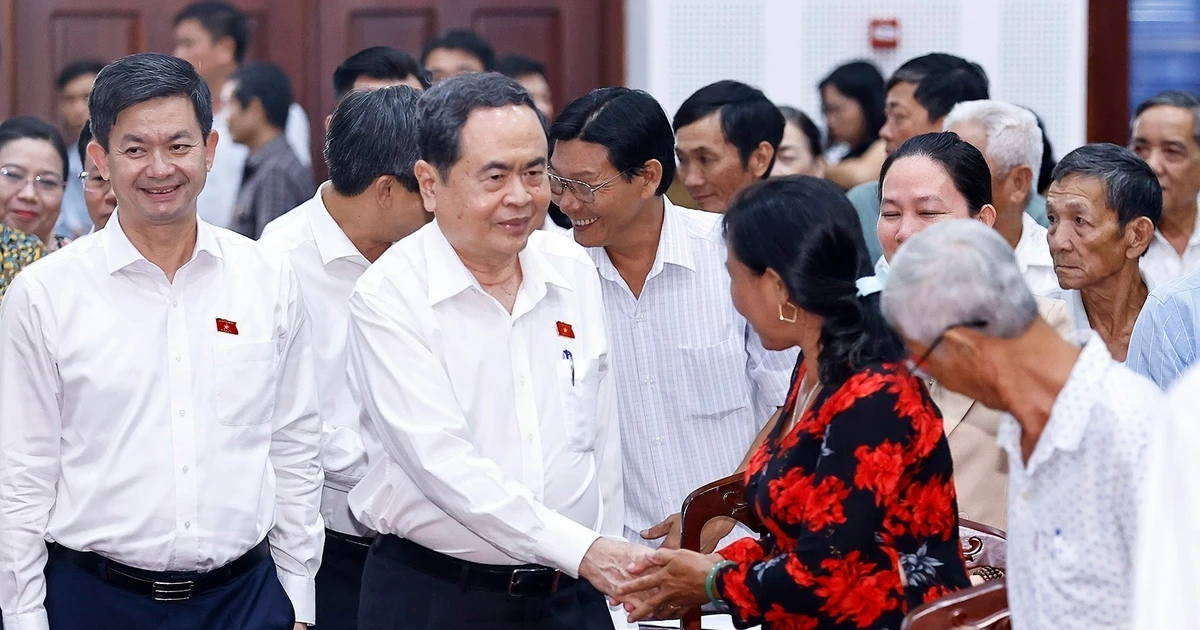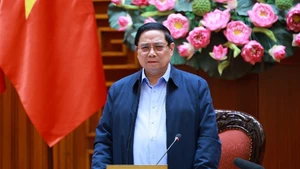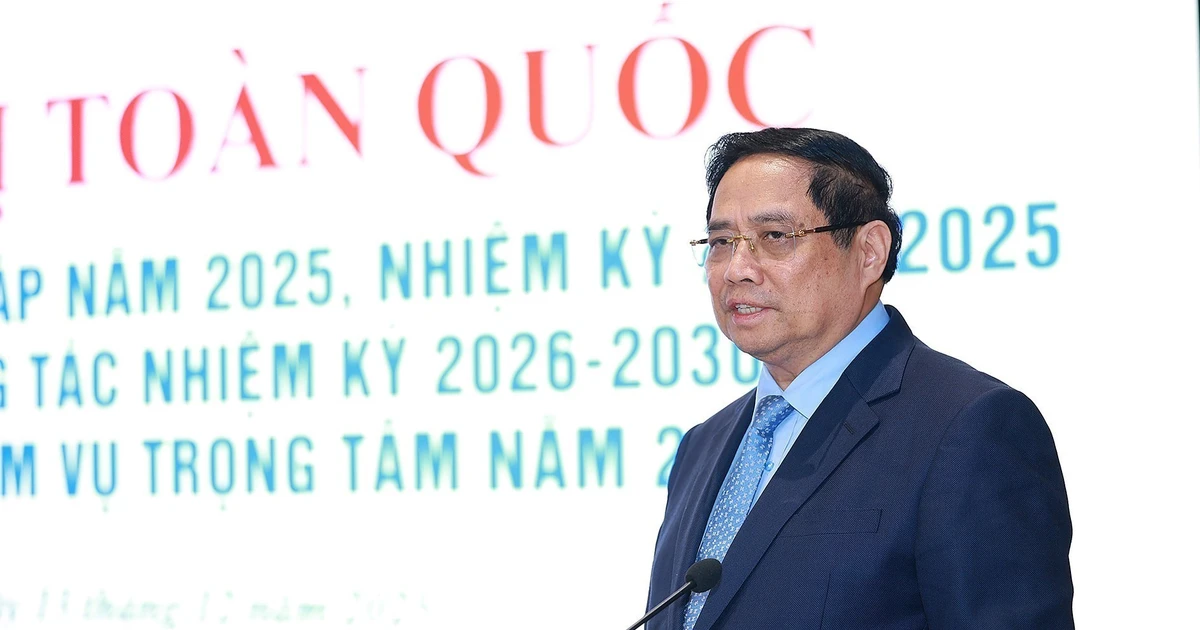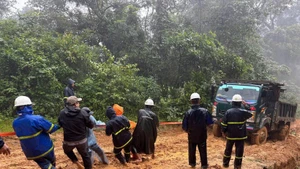At 5 am on April 29, the Politburo sent a telegram commending the units for their significant victories in recent days, while calling on the people, comrades, cadres, and soldiers to swiftly strike directly into the enemy’s final stronghold, annihilate all resistance, and combine attacks with uprisings to liberate Saigon–Gia Dinh completely.
The Politburo also reminded all units to strictly maintain discipline, thoroughly comply with all directives and orders, protect the lives and property of civilians, uphold the revolutionary spirit and the army’s tradition of absolute victory, and achieve complete success in the historic campaign named after the great President Ho Chi Minh.
At 10 am on April 29, the Politburo and the Central Military Commission issued an order to the Command of the Ho Chi Minh Campaign: …“continue to advance into Saigon according to the plan; march forward with the utmost momentum, liberate and take full control of the city, disarm the enemy’s forces, dismantle all levels of the enemy’s administration, and utterly crush any resistance.”
In the southeast, Army Corps 2 began shelling Tan Son Nhat Airport from 4:30 am. At 5:30 am on April 29, Division 304 (Army Corps 2) continued its assault on enemy positions at the infantry school, the armoured vehicle depot at Nuoc Trong base, and the Long Binh junction. By 10 am, Regiment 9 had secured the junction of Road 15, then Division 304 advanced along Road 15 to seize Song Buong Bridge and Long Binh base. The penetrating unit (comprising Armoured Brigade 203, Regiment 66, and artillery, engineering, and air defence units) quickly pushed forward, linking up with Commando Group 116 at Dong Nai Bridge, preparing for an assault into the city centre.
Simultaneously, Regiment 46 (Division 325) eliminated remaining targets in Nhon Trach before advancing towards Tuy Ha. The enemy resisted fiercely. Division 325 had to deploy part of Regiment 121 along with tanks for support. By 4 pm on April 29, Regiment 101, supported by tanks, joined Regiment 46 in a decisive assault. Three T-54 tanks approached within 500 metres of Tuy Ha Fortress, suppressing enemy fire with cannons and heavy machine guns. Regiment 46 launched a massive attack.
Battalion 3 of Regiment 101, led by T-54 tanks, stormed through the main gate and rapidly overran strongpoints. Tuy Ha Fortress was captured by 6 pm on April 29. Afterwards, Division 325 pursued the retreating enemy, crossed the river to seize the Cat Lai Naval Base, and continued advancing toward District 9 and the puppet Navy Command. Meanwhile, Division 3 advanced towards Vung Tau and liberated the town at 4 pm.
To the east, from the morning of April 29, Division 341 (Army Corps 4) led by tanks, systematically crushed multiple enemy strongholds. Upon encountering deep trenches at the Hoc Nai junction, tanks circled northwards to strike Bien Hoa. Simultaneously, Regiment 273 destroyed enemy forces at Long Lac railway station and seized Bien Hoa Airport, capturing Air Division 3 base.
After capturing the armoured base of Division 18 at Yen The, Regiment 270 and Division 6 seized the Hoc Ba Thuc artillery base, then circled Ho Nai to attack Long Binh. On the night of April 29, Division 6 broke through the enemy’s defences at the Ho Nai junction. However, due to fierce resistance, Army Corps 4 had not yet fully crossed Bien Hoa by evening.
Meanwhile, the deep-penetration unit of Army Corps 4, Division 7, advanced along Route 1, eliminating Marine Battalion 6 and elements of Regiment 82 (puppet Division 18), 1.5 kilometres from Ho Nai, and broke through Tam Hiep to accelerate their offensive.
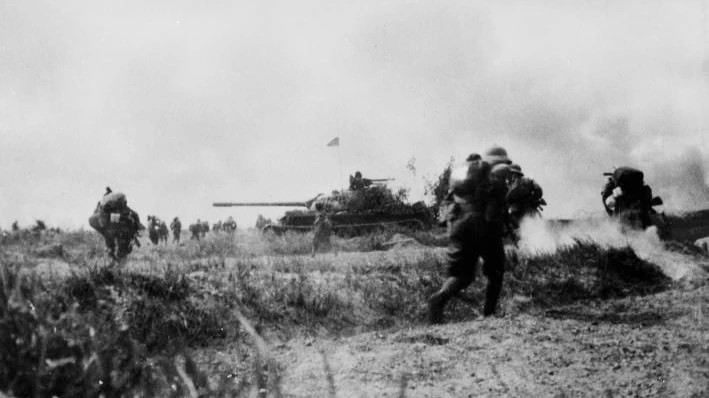 |
| Tank and infantry forces of the Division 320 captured the Dong Du base (Cu Chi) on the morning of April 29, 1975, breaking through the northwest “steel gate” of Saigon, paving the way for Vietnamese troops to advance deep and seize Tan Son Nhat Airport and the General Staff Headquarters of the Saigon puppet regime. (Photo: Le Trung Hung/VNA) |
Coordinating with the main forces, local forces in the outskirts operated effectively on April 29. Commando Group 116 attacked the enemy logistics command southwest of Long Binh, the Long Binh fuel depot, and secured the Dong Nai Highway Bridge. Commando Group 115 captured Ghenh Bridge for the second time and attacked the headquarters of the puppet Armoured Regiment 15 and the Hoc Ba Thuc logistics centre. Commando Group 10 seized Phuoc Khanh, Dong Tranh Junction, and destroyed 10 enemy ships on the Saigon River.
In the northwest, at 7 am on April 29, Division 316 repelled an enemy armoured group of seven tanks fleeing from Trang Bang toward Lao Tao, destroying two tanks at the hands of Battalion 3 (Regiment 174), while Battalion 1 eliminated two more in Phuoc My. The rest were neutralised. That same day, Battalion 3 (Regiment 174) captured Trung Hoa and Lao Tao, then coordinated with Battalion 1 to assault Phuoc Hiep and Dong Chua. At Trang Bang, Regiment 149 tightened the encirclement, destroyed Trang Chua Bridge, and secured key objectives. By 5 pm, Division 316 had taken full control of Trang Bang, annihilating and dispersing the enemy’s Regiments 46 and 49, Security Brigade 251, and an armoured combat team—effectively wiping out the puppet Division 25.
Also on April 29, Commando Regiment 198 (Army Corps 3) seized Bong Bridge, Sang Bridge, and defeated the Airborne Commando Battalion 81. Meanwhile, at 5:30 am, Division 320 attacked and by 11 am had completely annihilated the puppet Division 25, taking full control of Dong Du base.
Commando forces captured Bong Bridge and Sang Bridge on Route 1, paving the way for Army Corps 3 to advance into the city. At 5:25 am on April 29, Division 10 advanced along two axes. Regiment 24 with a tank battalion followed Highway 1, destroyed enemy forces at Hau Nghia and Cu Chi, then captured Quan Nam Fort and Hoc Mon. Regiment 28 and attached units took Phu Hoa Dong and Tan Quy before swinging back through Ba Ri and Tan Quy, crossing Dong Du and Bong Bridge to seize Quang Trung Training Centre. At 9 pm on April 29, Regiment 28 reached Ba Queo but faced heavy resistance and had to consolidate positions.
In the north, Division 312 (Army Corps 1) deployed Regiment 165 to encircle Phu Loi base while Regiment 209 blocked major roads and attacked enemy strongholds in An Loi, Tay Bridge, My Hanh, and Xoai Hamlet. A fierce battle for An Loi ensued, culminating in the collapse of the light command post of the puppet Division 5, whose leaders were captured at Phu Cuong.
On the Army Corps 1’s deep-penetration direction, Division 320B advanced rapidly. At 2 am on April 29, a motorised column of over 300 vehicles set off towards Lai Thieu–Saigon, clashing with enemy forces at Tan Uyen. By 4:30 am, Regiment 48 supported by tanks and artillery, coordinated with Regiments 64 and 27 to launch a three-pronged attack on Tan Uyen district. After 30 minutes of intense fighting, the area was secured, clearing the path to Lai Thieu and Saigon.
After a day of fierce fighting, Army Corps 1 shattered the enemy’s outer northern defences around Saigon. Division 312 successfully encircled and isolated the puppet Division 5, while Regiment 209 severed Routes 13 and 14. Division 320B penetrated deep into the enemy’s defences, pushing within 15km of the enemy’s headquarters in central Saigon.
Throughout April 29, local forces on the northern and northwestern fronts fought effectively. At 9:30 am, Gia Dinh Regiment 1 battled in Tan Thoi Nhat and Xuan Thoi Thuong (Tan Binh District), assisting the people in uprising and eliminating scattered enemy forces. Local forces and militia in Cu Chi surrounded and dismantled most enemy outposts, fully liberating Cu Chi District by evening of April 29.
Commando Regiment 115 liberated Tan Thoi Hiep, repelled airborne counterattacks, and seized Cho Moi Bridge. Other units captured Binh Phuoc Bridge, Quan Tre radio station, and Phu Dong artillery camp in Go Vap. Gia Dinh Regiment intercepted and defeated fleeing enemy units from Dong Du.
On the Western and Southwestern fronts, at 10:10 am on 29 April, Division 3 (Force 232) secured control of Hau Nghia Town, then advanced to capture Duc Hoa and Duc Hue sub-regions (at 2:30 pm) and Tra Cu base (at 6:20 pm), before organising a crossing of the Vam Co Dong River. Division 9 deployed its full force to cross My Hanh and then thrust deeper toward Ba Queo.
On the night of 29 April, Battalions 8 and 9 of Regiment 3 (Division 9) launched an assault, eliminating the headquarters of Regiment 8 and the Ranger Battalion 86 along the Dai Han Highway belt; they subsequently crushed the Security Battalion 327 retreating south of Vinh Loc from Duc Hoa toward Saigon. Battalion 7, reinforced with four PT85 tanks, attacked the Security Battalion 317’s position, killing or capturing 196 enemy troops. Divisions 5 and 8 maintained control of Route 4, firmly held their positions, and repelled multiple enemy counterattacks. Regiments 24 and 88 continued advancing toward northern Can Giuoc and Hung Long.
Coordinating with the main forces, the regional forces of Saigon–Gia Dinh operating in this sector also intensified their activities. Commando Regiment 429 attacked the Special Forces Battalion 8 at Tan Tao, Ba Hom, and Phu Lam radar station; they captured Hamlet 2 (Binh Tri Dong), Binh Hung, Ky Thuc On, and Nhi Thien Duong Bridge. Commando Regiment 117 launched Katyusha rocket attacks on Tan Son Nhat Airport. Local forces from Binh Chanh seized the Tan Tuc and Tan Hao sub-regions (in Tan Binh District) at 10:30 am.
By the end of 29 April, our forces had shattered the enemy's outer defensive line, destroying and dispersing most of the divisions 5, 25, 18, 22, and 7 of the puppet army. Deep-penetration units had pushed into the outskirts, only 10–20 kilometres from the centre of Saigon. Local armed forces were active across key areas, securing strategic bridges leading into the city.
On the enemy side, on 29 April, Cao Van Vien, Chief of the General Staff, along with many puppet senior officers fled. At 11:15 am, US President Gerald Ford ordered the launch of “Operation Frequent Wind,” the final helicopter evacuation to remove the remaining 5,000 Americans from South Vietnam.
In the Mekong Delta, starting from April 29, 1975, under a comprehensive coordination plan, main forces and local forces, together with the people of various provinces and districts, attacked enemy bases and facilities to liberate their local areas.
In Tra Vinh, on the night of April29, local forces and civilians simultaneously launched assaults on Tra Vinh Town, seizing and destroying 15 enemy outposts within the town, while political agitation units successfully mobilised uprisings at 28 outposts and bunkers, leading to the fall of Cang Long sub-region.
In Ha Tien, local forces attacked and completely liberated Phu My Commune in the morning, followed by the liberation of Binh An and Vinh Dien Communes in the afternoon.
In Ca Mau, on the night of April 29, local armed units and Region 9 forces launched coordinated attacks on enemy positions on the outskirts of the town, eliminating Hoa Thanh sub-region, Ao Kho outpost, Xi Cach, and Cai Nhuc; they besieged and forced the withdrawal of enemy forces from Lo Te (Tan Thanh) and the So Hai Bridge (Tan Loc) sub-regions. Enemy forces along the Ca Mau–Cai Nuoc route were completely cleared. By this time, enemy forces in Ca Mau had withdrawn into the inner town.
At sea, at 4:00 pm on April 28, our forces continued their operations to liberate Truong Sa (Spratly) Island—the southernmost island of the archipelago. By 9:00 am on April 29, our troops had landed and fully secured the island.
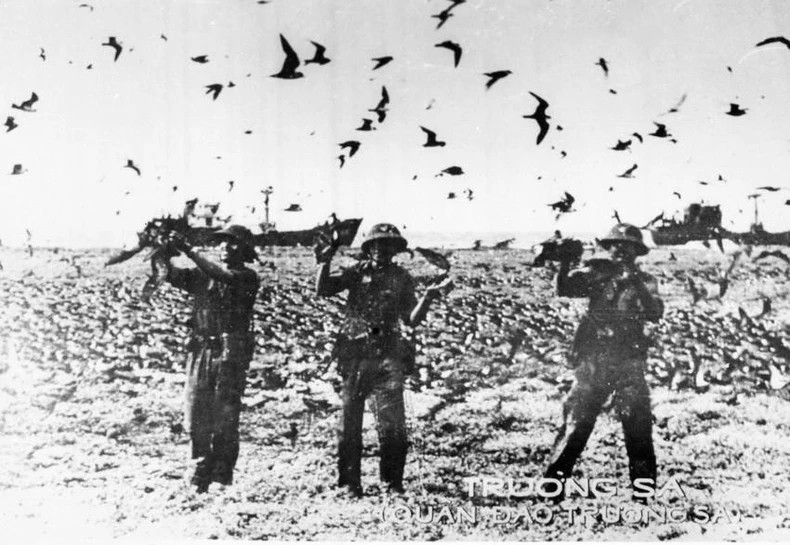 |
| Naval special forces of Brigade 126 on the liberated Truong Sa Island, April 29, 1975. (Photo: VNA) |
On April 29, the Standing Committee of the Central Office for South Vietnam continued issuing guidance on specific policies for newly liberated areas to the Regional Military Commission and Party committees at all levels, including policies for enemy soldiers, puppet government employees, and measures to maintain public order and security after liberation.
On the same day, at Davis Camp (located within Tan Son Nhat military airport, which housed the two military delegations of the Government of the Democratic Republic of Vietnam and the Provisional Revolutionary Government of the Republic of South Vietnam under the Four-Party and Two-Party Joint Military Commissions implementing the Paris Agreement), our delegations received constant requests for contact.
In the morning, US Ambassador Martin, via the Hungarian delegation, sent a message requesting a meeting with the Head of the military delegation of the Provisional Revolutionary Government of the Republic of South Vietnam, but this request was rejected.
From 11:00 am to 5:30 pm, three delegations of the “third force” came to request meetings. Our delegation received them and hand over Declaration of the Provisional Revolutionary Government of the Republic of South Vietnam dated April 26.
